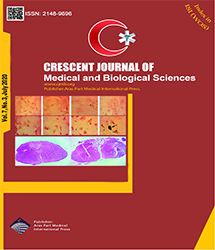
| Original Article | |
| Distribution of aac(6")/aph(2"), aph(3")-IIIa, and ant(4")-Ia Genes Among Clinical Nasal Sources for Staphylococcus aureus Strains Isolated in Korramabad, Iran | |
| Gholamreza Goudarzi1, Pegah Shakib1, Mozhgan Azadpour1, Mohamad Reza Nazer2 | |
| 1Razi Herbal Medicines Research Center, Lorestan University of Medical Sciences, Khorramabad, Iran 2Department of Infectious Diseases, School of Medicine, Lorestan University of Medical Sciences, Khorramabad, Iran |
|
|
CJMB 2020; 7: 429-433 Viewed : 71054 times Downloaded : 19294 times. Keywords : Staphylococcus aureus, Aminoglycoside-modifying enzymes, Multiplex-PCR |
|
| Full Text(PDF) | Related Articles | |
| Abstract | |
Objectives: The principal mechanism of resistance in many clinical isolates of Staphylococcus aureus involves the inactivation of aminoglycoside antibiotics by aminoglycoside-modifying enzymes (AMEs). The present study identified the antimicrobial susceptibility pattern and the prevalence of AMEs among S. aureus strains. Materials and Methods: To carry out this cross-sectional research, a total of 100 S. aureus were gathered from the university hospitals in Khorramabad, Iran, from January to November 2017. The antibiotic susceptibility pattern of the isolates was determined using the disk diffusion method according to the guidelines suggested by the Clinical Laboratory Standards Institute. The samples were assayed to detect the presence of three AME genes by the use of a triplex polymerase chain reaction (PCR) method. Results: The prevalence of S. aureus nasal carriage was 14.7% (50/340). In addition, 15%, 10%, 15%, and 8% of the total isolates were found to be resistant to gentamicin, amikacin, kanamycin, and netilmicin, respectively. Further, aac(6′)/aph(2′′), aph(3′)-IIIa, and ant(4′)-Ia genes were present in 17%, 12%, and 0% of the isolates, respectively. Based on the results, the double combination of aac(6′)/aph(2′′) and aph(3′)-IIIa genes were only observed among clinical-isolated strains (12/50, 24%), which predominantly were resistant to oxacillin (10/12, 83.3%). Eventually, the aac(6′)/aph(2′′) gene was found in all isolates that were phenotypically resistant to gentamicin and kanamycin. Conclusions: These findings indicated that resistance to aminoglycosides is significantly related to methicillin-resistance (P < 0.001). Due to the relatively high occurrence of the main genes modifying aminoglycosides in our region, it is recommended that clinicians combine aminoglycosides synergistically with other antibiotics such as beta-lactams in cases of empirical treatments. |
Cite By, Google Scholar
Google Scholar
PubMed
Online Submission System
 CJMB ENDNOTE ® Style
CJMB ENDNOTE ® Style
 Tutorials
Tutorials
 Publication Charge
Medical and Biological Research Center
About Journal
Publication Charge
Medical and Biological Research Center
About Journal
Aras Part Medical International Press Editor-in-Chief
Arash Khaki
Deputy Editor
Zafer Akan


















